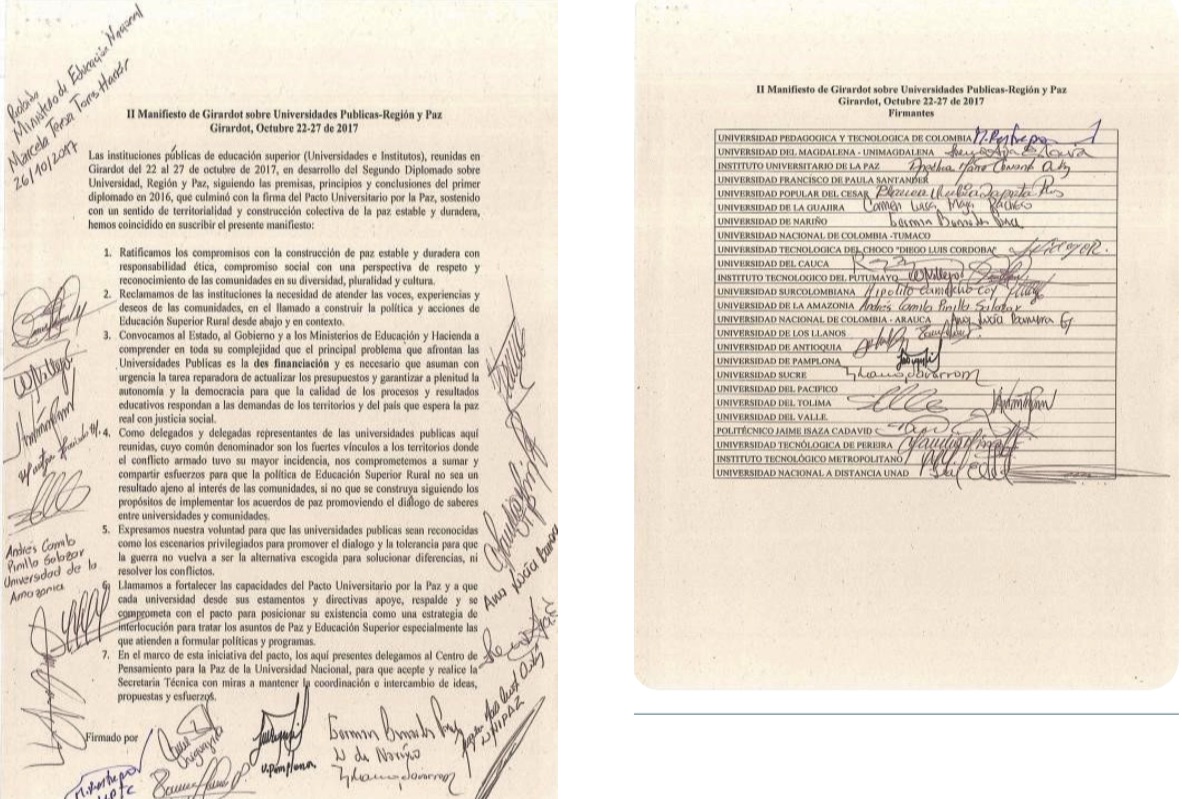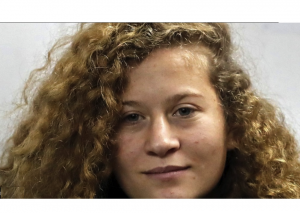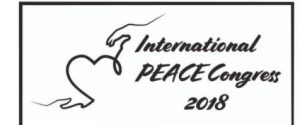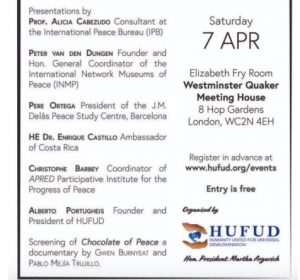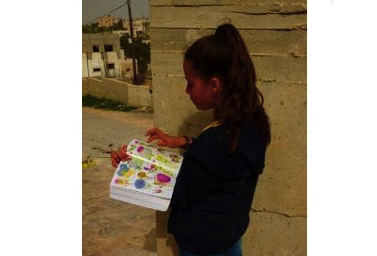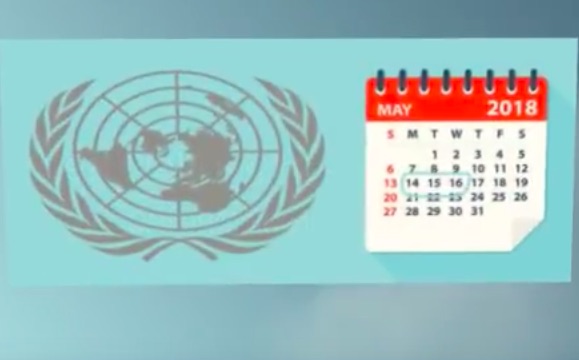DISARMAMENT & SECURITY .
An article by Marcia Chambers from the New Haven Independent
Abby Boyle, a junior at Branford High School, remembers the moment she took her cell phone to sign up her high school for the national student walkout to raise awareness about gun violence in the nation’s schools.
It was a moment she and others will never forget because it was part of a national event that has transformed her and hundreds of other Branford students, an event they organized.
“A big part of this was to show that our generation is going to make the change because we are the future, and we are soon to be adults. So it is like this is our time to really get out there and have them listen to us,” said Jayleen Flores (pictured), a senior and the president of the school’s Student Council.

Abby Boyle, Jayleen Flores, Andrew DeBenedictis, Mary Olejarzyk
(Bill O’Brien photo)
The national student walkout idea began on social media shortly after 17 students and teachers were gunned down in their classrooms on Feb. 14 at Florida’s Marjory Stoneman Douglas High School in Parkland, Florida. A former student armed with a high-powered assault rifle and determined to open fire went into the school and executed his plan.
Branford students created their own program, encouraged by school administrators to do so. The Walsh Intermediate School also had a program. The high school program held last Wednesday was led by Boyle and three other student leaders, Flores, a senior; Andrew DeBenedictis, a junior; and Mary Olejarzyk, a junior. Flores is student council president. The others all hold officer positions in various school organizations. (See photo)
The four students met with the Eagle last Friday in the office of High School Principal Lee Panagoulias, Jr., who said about 500 to 600 students attended the walkout program, which had been planned for outdoors, but was redirected to the school gym because it had snowed the day before. Those who did not participate went to the school auditorium. Faculty chose their destinations as well.
Olejarzyk said, “I think in terms of finding our voice, we were never told no. This administration was willing and excited to help us. In a lot of different schools in other parts of the country and even in Connecticut, kids were told they would be suspended if they walked out, and that is not personally what I think they should be saying. Young people were the lowest number of voters turning out in recent elections. I think we need to encourage voting, and I appreciate what our school did. They let us have our voice.”
The students said they would have liked the press to be there and one of them said she had contacted a local television station. “I think the press being there would have been nice, especially for us. I think it would have been nice because more people could have heard our story,” Boyle said.
Before last Wednesday’s event, the Eagle contacted Hamlet Hernandez, the district’s superintendent, to ask if we could cover the student program at the high school. He said it was closed to the press. He would not explain why it was closed to the press except to say some events were open and some were not.
Growing Up With Sandy Hook
Boyle, one of the high school’s leaders, wanted her school to be part of a program to commemorate the lives of those lost that day and to find a way to talk about safety for students. The attack on the Florida high school was the 17th school shooting in the U.S. in the first 45 days of 2018.
These Branford teens have lived with kids being killed in their classrooms since they were 12. They said they all remember well when a young man named Adam Lanza walked into the Sandy Hook Elementary School in Newtown, Connecticut, five years ago and opened fire, killing 20 children, ages 6 to 7 years old, and six educators, including teachers and the school principal. Then he killed himself. He had earlier killed his mother.
Abby Boyle, a junior at Branford High School, remembers the moment she took her smart phone to sign up her high school for the national student walkout to raise awareness about gun violence in the nation’s schools.
It was a moment she and others will never forget because it led to a national event that has transformed her and hundreds of other Branford students.
When Olejarzyk spoke before those in the high school gym she read a letter she wrote to U.S. Sen. Chris Murphy of Connecticut, who in the aftermath of Sandy Hook has devoted himself to changing how the nation deals with guns and the law. In her letter she told Murphy what it was like “to be our age and to grow up in an age of Sandy Hook. This has to stop.”
Murphy, along with U.S. Sen. Richard Blumenthal and U.S. Reps. Rosa DeLauro and Elizabeth Esty spoke to the thousands of students who assembled at the National Student Walkout in Washington, D.C.
Olejarzyk told Murphy what it has been like “with this constant news of new mass shootings in schools in other places. This affects us.” She said she wrote Murphy that “we are ready to make the change; we are ready when we are 18 vote for officials who will make the change on what should be adopted.”
Boyle said she started the process to involve BHS in the national student walkout “about one month ago,” after she learned about the walkout on social media. “The idea was to get kids involved and to raise awareness against gun violence and to show remembrance for all the victims lost due to that violence and to show Congress that we care.”
Thousands of students in schools across the state and country walked out on the morning of March 14, each school doing it their own way. In nearby Guilford the students walked out of their classrooms and onto the street, standing in front of their school. Other kids took to their local town or city halls. But some Connecticut school districts threatened to suspend students for walking out, not happy with the idea that students would create their own independent program.
(Article continued in right column)
Question related to this article:
Do you think handguns should be banned?, Why or why not?
(continued from left column)
Student Chosen Themes
At the Branford High gym, each of the four student leaders, led with a theme. Boyle began with a Remembrance, reading aloud the 17 names of those shot to death. Flores spoke about students finding a voice. DeBenedictis spoke about student unity, and Olejarzyk spoke about teenage life and its challenges.
The Branford students defined the walkout as leaving their classrooms, not necessarily leaving the building. “We all physically left the classroom. There were a lot of different ways to do this and this is the way we chose it,” DeBenedictis said. He added that it had snowed the day before and the student leaders didn’t feel comfortable forcing everyone out. We decided it was better to have it in the gym,” he said, adding it was easier to hear in the gym than on the field.
Flores got right to the point on the location issue. “When I spoke I made the point that it doesn’t matter where we’re standing, but that we are standing. Some people were pretty upset that we weren’t going out, but it shouldn’t matter where we are. It is what we are standing up for.”
All four were highly aware of the fact that they may well be the generation to change America’s thinking about guns, violence, and schools. Each has come to see how they empowerment works; each has now discovered an inner voice they want to share with others.
DeBenedictis said, “And what we are seeing in Congress is that actions that should have been happening haven’t taken place over the last 20 years where school shootings have become increasingly more common. And because our politicians really aren’t taking care of this we felt it was time for students to step up and start fighting for ourselves.”
Olejarzyk agreed. “I think what happened in Florida really resonated with people our age because we are very politically aware and after what the students in Parkland started we felt really inspired to help make their message louder up here.”
The Eagle asked each student what he or she took away from the experience.
Boyle said, “I guess what I felt thinking back a few weeks ago when I found this (demonstration) on the internet, I said I am going to set up my school for this and see what happens. I was thinking this probably won’t be a big thing. And it is just so surreal to see that we were part of this movement and that we are such a small little school, in a small town, in a small state, but it really shows that our actions matter, that we could do something really huge.”
DeBenedictis said, “When all was said and done, thousands if not hundreds of thousands of students at schools participated in this across the country. We are writing history in textbooks for one of the largest student movements in history.
“This really helped us find a voice, a united front. I think this is an issue that students need to be organized on. As young people we found a voice on this issue. With the march on Washington coming, it is really good that we are making this all happen,” DeBenedictis added.
Panagoulias, who let the students do virtually all the talking at the interview, was asked by the Eagle about earlier student movements in American history.
He remembered demonstrations of decades past. “During the ’70s it was a lot of us versus them, students versus the institution. I think one of the things Branford chose to do is to support their kids. This was a great opportunity for the entire learning community. Some teachers went out. Some didn’t.”
The principal asked the four students, “If you wanted to go outside do you think we would have supported that?”
“Yes,” Boyle said. “It didn’t matter where.” DeBenedictus observed that in the gym “we could hear each other speaking.”
What the four students said they learned was that coming together changed how they think. Each seemed to have found new goals and a new direction that would take them outside themselves in the future.
Voting in Elections
Asked if they had registered to vote, all said they have pre-registered to vote so that may do so when they turn 18. The principal said “We will have the Registrars of Voters here in the spring when more kids are of age so that they can register.”
Boyle delivered the register to vote message to the hundreds of students gathered in the gym. “Our decisions matter. Each and every one of us has to register to vote. We need support. Our generation needs to have a voice.” The energy in the gym after a walk-out that lasted 17 minutes was intense, she said. “ This was an overflowing of energy, of positivity. Everyone was commenting. It was really awesome,” she said.
Flores said, “Everyone I talked to left with a great feeling afterward. They were inspired.”
DeBenedictis pointed out that for many people “this was their major political event, for many this was the first time they made a poster, or came out because they were passionate about something and that was a really big deal for a lot of students. I think that will inspire them in the future, to stand up for what they believe in.
“One other thing I want to add. I think this idea that young people are completely apathetic about politics, I think that is declining. If you look at our generation, how passionate we are about these issues that are affecting us, I think young people are really waking up. I think it will explode in 2016 and especially in the presidential election in 2018.”
Other Points of View
Those students who did not walk out may still be involved in many of the issues, Panagoulias observed.
“Those students may be involved but they may have different opinions. Because they chose not to participate it may mean they have different viewpoints but they may still be involved.”
Boyle said that while the focus of her program was not guns or violence “we brought it up and mentioned it, and some people have really strong opinions about gun restrictions and gun laws.
“Even if you may have a different opinion than me or any of us here today, we can still work together to come up with a better solution. You know it is not always about being so left or so right. Like sometimes you have to be in the middle to find a solution. I think many do not realize that.”
